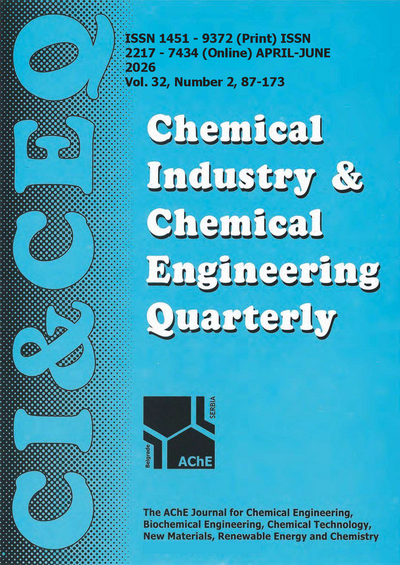COMPARATIVE ANALYSIS OF MORINGA OIL AND RUBBER SEED OIL BIODIESELS IN DIESEL ENGINES
Original scientific paper
DOI:
https://doi.org/10.2298/CICEQ241211018PKeywords:
Biodiesel, Biodiesel, diesel engine, alternative fuel, moringa oil, rubber seed oil, emissionsAbstract
Energy resources are diminishing, and environmental problems are becoming more prevalent. In this regard, biodiesel from moringa oil (MO) and rubber seed oil (RSO) promises to be an excellent alternative to diesel fuels, while also requiring far less modification from existing diesel engines. Performance metrics analysis reveals that biodiesel consumes a slightly higher amount of fuel at lower loads because of its relatively lower calorific value. At 4.4 kW, MO methyl ester blend (MO20) achieved a brake thermal efficiency of 30%, outperforming diesel (26%) and RSO methyl ester blend (RB20) achieved a brake thermal efficiency of 28%. MO20 reduced CO emissions by 60% compared to diesel and 55% compared to RB20. Furthermore, MO20 increased NOx emissions by 10% at higher brake power levels compared to RB20 and 20% for diesel. RB20 and MO20 biodiesel blends exhibit lower HC compared to diesel by 24% and 28% respectively. These reductions in carbon monoxide and hydrocarbon emissions make biodiesel blends, mostly from MO, cleaner and well sustainable compared to conventional diesel, with their environmental and performance benefits for diesel engine applications.
References
[1] . N.R. Abdullah, M.S.M. Zaharin, A.M.I. Mamat, M.R.M. Nawi, H. Sharudin, J. Technol. 76(11) (2015) 107–112. https://doi.org/10.11113/jt.v76.5920.
[2] D. Agarwal, A.K. Agarwal, Appl. Therm. Eng. 27(13) (2007) 2314–2323. https://doi.org/10.1016/j.applthermaleng.2007.01.009.
[3] A.K. Azad, M.G. Rasul, M.M.K. Khan, S.C. Sharma, R. Islam, Procedia Eng. 105 (2015) 601–606. https://doi.org/10.1016/j.proeng.2015.05.037.
[4] S.C.A. De Almeida, C. Rodrigues Belchior, M.V.G. Nascimento, L. Dos, S.R. Vieira, G. Fleury, Fuel 81(16) (2002) 2097–2102. https://doi.org/10.1016/S0016-2361(02)00155-2.
[5] F. Hussain, M.E.M. Soudagar, A. Afzal, M.A. Mujtaba, I.M. Rizwanul Fattah, B. Naik, B.M.H. Mulla, I.A. Badruddin, T.M. Yunus Khan, V.D. Raju, R.S. Gavhane, S.M. Ashrafur Rahman, Energies 13(17) (2020) 4578. https://doi.org/10.3390/en13174578.
[6] S. Jindal, B.P. Nandwana, N.S. Rathore, V. Vashistha, Appl. Therm. Eng. 30(5) (2010) 442–448. https://doi.org/10.1016/j.applthermaleng.2009.10.004.
[7] V. Karthickeyan, Fuel 235 (2019) 538–550. https://doi.org/10.1016/j.fuel.2018.08.030.
[8] B. Kathirvelu, S. Subramanian, Environ. Eng. Res. 22 (2017) 294–301. https://doi.org/10.4491/eer.2016.145.
[9] S. Murillo, J.L. Miguez, J. Porteiro, E. Granada, J.C. Moran, Fuel 86 (2007) 1765–1771. https://doi.org/10.1016/j.fuel.2006.11.031.
[10] A.N. Ozsezen, M. Canakci, Energy Convers. Manage. 52 (2011) 108–116. https://doi.org/10.1016/j.enconman.2010.06.049.
[11] A.S. Ramadhas, S. Jayaraj, C. Muraleedharan, Renew. Energy 30 (2005) 795–803. https://doi.org/10.1016/j.renene.2004.07.002.
[12] P. Raghu, R. Sundarrajan, R. Rajaraman, M. Ramaswamy, S. Sathyanaryanan, Int. J. Veh. Struct. Syst. 12 (2020) 82. https://doi.org/10.4273/ijvss.12.1.18.
[13] K. Rajan, R. Pradeepraj, Int. J. Innov. Technol. Explor. Eng. 9 (2020) 1783–1786. https://doi.org/10.35940/ijitee.B7242.019320.
[14] S. Rajaraman, G.K. Yashwanth, T. Rajan, R. Siva Kumaran, P. Raghu, Proc. ASME Int. Mech. Eng. Congr. Expo. 2009 Volume 3: Combustion Science and Engineering, 13–19, (2009) pp. 27-34. https://doi.org/10.1115/IMECE2009-11265.
[15] A.S. Ramadhas, C. Muraleedharan, S. Jayaraj, Renewable Energy 30 (2005) 1789–1800. https://doi.org/10.1016/j.renene.2005.01.009.
[16] S. Ramalingam, N.V. Mahalakshmi, RSC Adv. 10 (2020) 4274–4285. https://doi.org/10.1039/c9ra09582a.
[17] M.M. Rashed, M.A. Kalam, H.H. Masjuki, M. Mofijur, M.G. Rasul, N.W.M. Zulkifli. Ind. Crops Prod. 79 (2016) 70–76. https://doi.org/10.1016/j.indcrop.2015.10.046.
[18] U. Rashid, F. Anwar, B.R. Moser, G. Knothe, Bioresour. Technol. 99 (2008) 8175–8179. https://doi.org/10.1016/j.biortech.2008.03.066.
[19] M. Salaheldeen, M.K. Aroua, A.A. Mariod, S.F. Cheng, M.A. Abdelrahman, A.E. Atabani, Energy Convers. Manage. 92 (2015) 535–542. https://doi.org/10.1016/j.enconman.2014.12.087.
[20] S. Saravanan, G. Nagarajan, G. Lakshmi Narayana Rao, S. Sampath, Energy 35 (2010) 94-100. https://doi.org/10.1016/j.energy.2009.08.029.
[21] S. Sivalakshmi and T. Balusamy, Int. J. Ambient Energy 32 (2011) 170–178. https://doi.org/10.1080/01430750.2011.625717.
[22] M.E.M. Soudagar, H.M. Khan, T.M. Yunus Khan, L. Razzaq, T. Asif, M.A. Mujtaba, A. Hussain, M. Farooq, W. Ahmed, K. Shahapurkar, A. Alwi, T.M. Ibrahim, U. Ishtiaq, A. Elfasakhany, M.A.A. Baig, M.S. Goodarzi, M.R. Safaei, Appl. Sci. 11 (2021) 7071. https://doi.org/10.3390/app11157071.
[23] P. Tamilselvan, N. Nallusamy, S. Rajkumar, Renew. Sustain. Energy Rev. 79 (2017) 1134–1159. https://doi.org/10.1016/j.rser.2017.05.176.
[24] B.K. Venkanna, C.V. Reddy, Int. J. Energy Technol. Policy 9 (2013) 1–14. https://doi.org/10.1504/IJETP.2013.055813.
[25] A.K. Agarwal, Renew. Sustain. Energy Rev. 150 (2022) 111551. https://doi.org/10.1016/j.rser.2021.111551.
[26] A. Demirbas, Energy Convers. Manag. 226 (2021) 113528. https://doi.org/10.1016/j.enconman.2020.113528.
[27] U. Rashid, Bioresour. Technol. 351 (2022) 126891. https://doi.org/10.1016/j.biortech.2022.126891.
Downloads
Published
Issue
Section
License

This work is licensed under a Creative Commons Attribution-NonCommercial-NoDerivatives 4.0 International License.
Authors who publish with this journal agree to the following terms:
Authors retain copyright and grant the journal right of first publication with the work simultaneously licensed under a Creative Commons Attribution License that allows others to share the work with an acknowledgement of the work's authorship and initial publication in this journal.
Authors grant to the Publisher the following rights to the manuscript, including any supplemental material, and any parts, extracts or elements thereof:
- the right to reproduce and distribute the Manuscript in printed form, including print-on-demand;
- the right to produce prepublications, reprints, and special editions of the Manuscript;
- the right to translate the Manuscript into other languages;
- the right to reproduce the Manuscript using photomechanical or similar means including, but not limited to photocopy, and the right to distribute these reproductions;
- the right to reproduce and distribute the Manuscript electronically or optically on any and all data carriers or storage media – especially in machine readable/digitalized form on data carriers such as hard drive, CD-Rom, DVD, Blu-ray Disc (BD), Mini-Disk, data tape – and the right to reproduce and distribute the Article via these data carriers;
- the right to store the Manuscript in databases, including online databases, and the right of transmission of the Manuscript in all technical systems and modes;
- the right to make the Manuscript available to the public or to closed user groups on individual demand, for use on monitors or other readers (including e-books), and in printable form for the user, either via the internet, other online services, or via internal or external networks.






